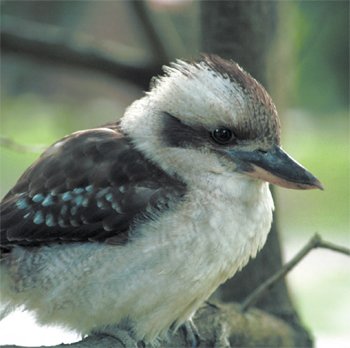Kookaburra
Excerpt from Marvels of Creation: Breathtaking Birds
by Buddy Davis and Kay Davis on April 18, 2013One of the most easily recognized birds in Australia is the kookaburra.

One of the most easily recognized birds in Australia is the kookaburra, a large kingfisher which lives in parks, woodlands, and forests in eastern Australia. The kookaburra has been introduced to western Australia and is also found in Tasmania.
The plumage of the kookaburra is dark on the back down to the rusty-colored tail. The wings are dark also with white markings on them. The kookaburra is white or light gray elsewhere except for the black slash across the eyes. The heavy beak is dark on top, yellow-brown on bottom, and is approximately 3 to 4 inches (8 to 10 cm) long.
If you are in the Australian bush and hear loud laughter, it is probably a kookaburra claiming territory. The sounds of this noisy bird were used in the old Tarzan movies even though it lives far from the African jungle.
Kookaburras like to perch on a branch or wire searching for prey. Peculiarly, they are known as kingfishers, but their diet consists not of fish, but of invertebrates—lizards, snakes, frogs, small mammals, and other birds. Catching its prey on the ground, the kookaburra will carry it into a tree or onto a large rock and then bash it on the branch or rock to kill it. Sometimes, they drop their prey to the ground, smashing it and killing it.
The nest of the kookaburra is made in hollow trees or in a termite mound. If it uses a termite mound, it digs a burrow into the mound and leaves it for a week. During this time, the termites seal their tunnels making it more comfortable for the birds. One to four white eggs are laid and incubated by both parents and a “helper” for about 25 days. These “helpers” are young birds around four years of age that have not mated. The helpers aid in 30 percent of the incubation and up to 60 percent of food gathering for the chicks. Young birds are born naked but in a week or two start growing feathers which are protected inside sheaths until the hatchling is ready to leave the nest in about 30 days. Parents continue to feed the young birds for another 40 days. While inside the nest, the young also feed on the remainder of insects, pellets, and small flies that have been consuming eggshell debris. Young kookaburras autograph their nest entrance by backing up to the nest opening and depositing their waste. This is called “signposting.”
There are about 85 species of known kingfishers worldwide. How many would God have had to bring to Noah and his family for the ark? Only one male and one female.
Laughing Kookaburra
Coraciiformes • Alcedinidae
Dacelo gigas
Weight: 14 ounces (380 g)
Length: 17 inches (22 cm)
Life Span: 12 years, although some in captivity may live 20 years
Special Design Feature: The long, strong bill of the kookaburra allows
it to capture a variety of small prey.
Did you know? The cry of the kookaburra sounds like loud human laughter.
- © 2024 Answers in Genesis
- Privacy Policy
- Contact
- About
